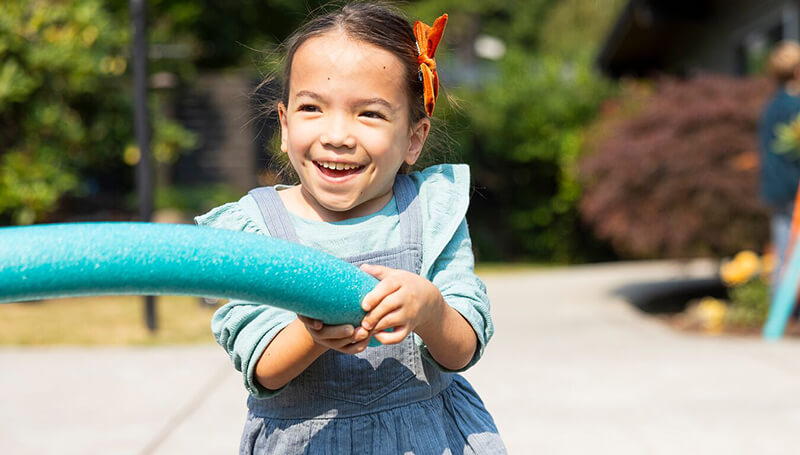Good Growing
Fall 2024
Help Kids Avoid Toxic Gaming
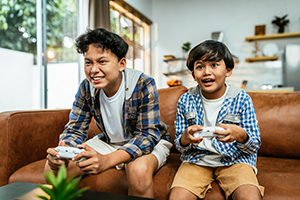 Online gaming can be tons of fun for people of all ages. Multiplayer games like Animal Crossing, Fortnite and Minecraft give players a chance to socialize, practice teamwork and solve problems. For kids especially, gaming shows them they can improve their skills through practice. It can also be a platform for teaching them to cope with frustration and disappointment when things don’t go their way.
Online gaming can be tons of fun for people of all ages. Multiplayer games like Animal Crossing, Fortnite and Minecraft give players a chance to socialize, practice teamwork and solve problems. For kids especially, gaming shows them they can improve their skills through practice. It can also be a platform for teaching them to cope with frustration and disappointment when things don’t go their way.
Online gaming also has downsides. It can pull kids away from other essential activities like physical exercise, sleeping, schoolwork and family time — which is why it’s so important to have a healthy balance of screen time. And because multiplayer online gaming allows players to talk with and message other players in real time, it can expose them to risks. Kids may experience extreme trash talking, profanity and even bullying. Gamers call this ‘toxic’ behavior — which can also include spamming hurtful messages and ‘trolling’ or harassing players.
How can parents help protect kids from toxic behavior in online gaming? Forest Coyle, a therapeutic gaming specialist at Seattle Children’s, says it’s about teaching kids how to respond to negative interactions. He encourages players to know when to report, mute and block toxic gamers. He adds, “Most games and gaming consoles have great parental controls that allow online gameplay while restricting communication features like text messaging and voice chatting. This is especially helpful for parents of younger gamers.”
Before allowing kids to play new games, parents should research them using ESRB ratings and reviews from trusted sources. Then, allow game play in open, high-traffic areas of your home where you can easily see what’s going on. Check in with your child often to get a feeling for their mood. Ensure they’re being respectful to others and encourage them to leave a game if there’s toxic behavior.
Also be certain your child understands how to stay safe online. Younger kids should only play with friends and family they know in person. Older kids must never share personal information or agree to meet with gamers they don’t know in real life. Be sure your child knows they should come to you right away if any interaction ever feels bad or weird.
Gaming can be a great way to bond as a family. Ask your child to teach you their favorite game so you can join them sometimes. And if you’re a gamer yourself, be a positive role model. Show them examples of how to interact with others online and be sure your child sees you being respectful and supportive of other gamers.
Need help balancing screen time with other activities? Create a media-use plan that works for your family.
Back Seat Until Age 13
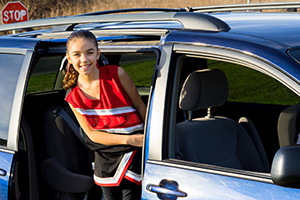 When can a child sit in the front seat of the car? In Washington state, not until they’re 13. This law is all about safety. Most crashes occur in the front of the car, and the back seat is farthest from the point of impact. Plus, air bags are designed for adults, not kids. In the U.S. in recent years, more than 100 children have been killed by air bags — and many of these deaths happened in slow-speed collisions.
When can a child sit in the front seat of the car? In Washington state, not until they’re 13. This law is all about safety. Most crashes occur in the front of the car, and the back seat is farthest from the point of impact. Plus, air bags are designed for adults, not kids. In the U.S. in recent years, more than 100 children have been killed by air bags — and many of these deaths happened in slow-speed collisions.
It’s natural for kids to want to ride in the front seat, and you may know families who allow their under-13 kids to do so. But riding in the back seat must be the rule. Don’t allow your child to sit up front as a reward or as a ‘treat’ in Grandpa’s car.
Learn more about car seat safety for all ages, including how to know if your growing child still needs a booster seat. Join us for a free car seat safety check with certified Child Passenger Safety Technicians.
Stay Curent On Vaccines
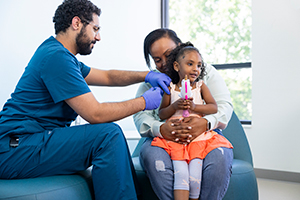 In a recent study, one-third of parents reported that their youngest child missed a vaccination due to the pandemic and its ripple effects. If your child is behind on vaccines, it’s not too late to catch up. Immunization is crucial to help keep children healthy and safe. It strengthens a child’s immune system and teaches the body to fight certain diseases. Vaccines reduce the chances of getting ill and protect those who do get ill from potentially serious outcomes.
In a recent study, one-third of parents reported that their youngest child missed a vaccination due to the pandemic and its ripple effects. If your child is behind on vaccines, it’s not too late to catch up. Immunization is crucial to help keep children healthy and safe. It strengthens a child’s immune system and teaches the body to fight certain diseases. Vaccines reduce the chances of getting ill and protect those who do get ill from potentially serious outcomes.
Your doctor can tell you if your child needs any regular childhood vaccines to protect against diseases like chickenpox, HPV, measles, meningitis, mumps, polio, whooping cough and others.
Also be sure your child is protected from seasonal viruses. Here are the current recommendations for seasonal vaccines:
COVID-19: The Centers for Disease Control (CDC) recommends that everyone ages 6 months and older gets an updated 2024–2025 COVID-19 vaccine this fall, whether or not they’ve previously received a COVID-19 vaccine.
Flu: The CDC recommends everyone ages 6 months of age and older (with rare exceptions) receives an updated 2024–2025 fl u vaccine this fall.
RSV: If you have a baby this fall, this winter or early next spring, ask their doctor about RSV (respiratory syncytial virus) immunization.
If your child has fallen behind on their vaccines — or if you’re not sure — check with their doctor and get their protection up to date as soon as possible.
Edible Cannabis Poisonings
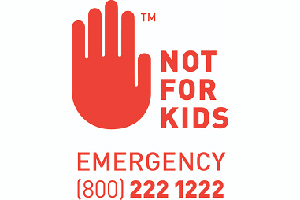 For children younger than 6, the rate of accidental poisonings from edible cannabis has risen dramatically in recent years. These products can be very attractive to kids because they’re often packaged to look like regular candies, snacks, baked goods and drinks. Because it can take a while for symptoms to show after a child eats or drinks these edibles, caregivers may not even know what happened. So, it’s important to know the effects, which may include vomiting or feeling nauseated, dizzy, drowsy or confused. A rapid heart rate is also possible. The effects can last for hours, and a child with severe symptoms might require admission to a hospital for monitoring.
For children younger than 6, the rate of accidental poisonings from edible cannabis has risen dramatically in recent years. These products can be very attractive to kids because they’re often packaged to look like regular candies, snacks, baked goods and drinks. Because it can take a while for symptoms to show after a child eats or drinks these edibles, caregivers may not even know what happened. So, it’s important to know the effects, which may include vomiting or feeling nauseated, dizzy, drowsy or confused. A rapid heart rate is also possible. The effects can last for hours, and a child with severe symptoms might require admission to a hospital for monitoring.
If you know or suspect your child has ingested cannabis, call Poison Control right away at 1-800-222-1222. Store edibles out of sight, out of reach and locked up to keep young children and curious older kids safe. Keep cannabis edibles in their original packaging and do not consume them in front of children.
Bathtub Safety
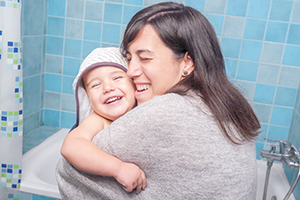 Every year in the U.S., nearly 90 children drown inside the home, and two-thirds of these deaths occur in the bathtub. Babies and toddlers can drown in as little as 2 inches of water — and it can happen in seconds.
Every year in the U.S., nearly 90 children drown inside the home, and two-thirds of these deaths occur in the bathtub. Babies and toddlers can drown in as little as 2 inches of water — and it can happen in seconds.
Never leave a baby or toddler alone in the bathtub. Before you put them in the tub, be sure you have all the supplies and clothes you need. Then, stay with your child and give them 100% of your attention. Don’t let your phone, the doorbell or a kitchen timer tempt you to leave your child. And remember that adult supervision is crucial; never rely on another young child to watch your little one in the tub.
Learn more about water safety for children birth to 5 years.
Developing a Growth Mindset
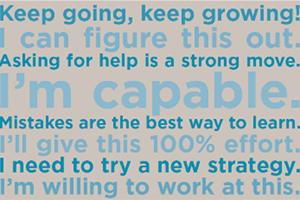 We want our kids to be persistent and resilient when they deal with challenges. We want them to learn and grow from their mistakes. And we want to empower them to feel optimistic, motivated and adventurous in childhood and beyond.
We want our kids to be persistent and resilient when they deal with challenges. We want them to learn and grow from their mistakes. And we want to empower them to feel optimistic, motivated and adventurous in childhood and beyond.
These ideas are at the heart of what’s called a growth mindset, a term originally created by Carol Dweck, an educational psychologist. This concept is now being taught in schools as a key part of social-emotional learning.
Teaching kids to embrace a growth mindset means helping them believe they can improve their skills through effort. By working hard, they have the power to change things. For example, if they struggle with reading, they don’t tell themselves, “I’m bad at reading and I always will be.” (This attitude is what’s known as a fixed mindset.) Instead, a growth mindset helps them fully believe they can improve their reading skills by working hard, practicing and accepting help from others.
Here’s one very simple way to help your child build a growth mindset. When your child says, “I can’t do this,” teach them to change that thought to “I can’t do this yet.” Help them believe that they’ll get the hang of it with lots of practice, and that practice is supposed to have lots of mistakes. Praise their willingness to accept their mistakes as part of the process — and proof of their progress. It’s a guaranteed way to build new skills!
Changing our language (including our internal self-talk) is key to changing our mindset. Help your child create some powerfully positive affirmations like those shown here. Reassure them that a steep learning curve usually feels very uncomfortable — and if they persist, they’ll conquer it.
Everyone can learn, change and grow. A growth mindset will not only help your child succeed in school, it will also equip them to have a happy, fulfilling life!
Check out these positive parenting resources.

